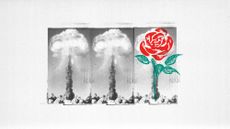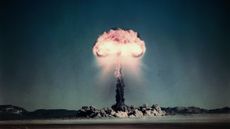Nuclear attack advice: what Brits should do
Threat of nuclear war ‘back on disaster planners’ agenda’ following Russia’s invasion of Ukraine

Britain should “dust off” its nuclear defence plans as the conflict between Russia and Ukraine escalates, an expert has warned.
The launch of a full-scale attack on Ukraine by Russia has put the threat of nuclear war “back on disaster planners’ agenda”, said The Telegraph.
Although a nuclear strike on the UK is still very unlikely, the risk is now “closer now than any time since the 1970”, a nuclear weapons expert told the paper as Whitehall’s plans for any such attack come under renewed scrutiny.
Subscribe to The Week
Escape your echo chamber. Get the facts behind the news, plus analysis from multiple perspectives.

Sign up for The Week's Free Newsletters
From our morning news briefing to a weekly Good News Newsletter, get the best of The Week delivered directly to your inbox.
From our morning news briefing to a weekly Good News Newsletter, get the best of The Week delivered directly to your inbox.
“In the depths of the Cold War, we were very prepared and there was a realisation an attack was a reality,” said former British Army chemical and nuclear weapons expert Hamish de Bretton-Gordon, now a fellow at Cambridge University’s Magdalene College.
Back then, “we had hundreds of bunkers around the country”, he continued. “But fast forward to 2022 and a lot of the planning and infrastructure has gone into abeyance and crumbled.”
Current state of play
Much of the UK’s nuclear defence infrastructure has been decommissioned as the threats of the Cold War faded, but a deep complex named Pindar remains under the Ministry of Defence that would “house the UK’s government and military leaders in the event of a nuclear strike”, said The Telegraph. And other nuclear response facilities are in place at other locations, including a command-and-control complex at RAF Corsham in Wiltshire.
“They probably need a bit of a dust off but they would be viable. I don’t have any insider information but there are probably a lot of civil servants running around at the moment making preparations,” said nuclear weapons expert de Bretton-Gordon.
Russia is believed to have the largest nuclear arsenal in the world, with 4,497 nuclear warheads, following by the US, with 3,750, according to the Arms Control Association. The UK has just 225.
The immediate aftermath
An intercontinental ballistic missile (ICBM) with nuclear warheads fired from Moscow or central Asia would probably take about 20 minutes to strike London, The Telegraph reported in 2017.
US-style sirens are unlikely to be used as a warning if an attack occurs, however. The “four-minute warning” air raid signals operated during the Cold War were almost entirely dismantled by the 1990s, so it is more likely that TV and radio would instantly switch to the news.
Text messages could also be used to send out warnings, although no system is known to have been set up for the purpose of a nuclear attack. A spokesperson for EE told the BBC in 2018 that the UK government was “working with the mobile industry to put this capability in place”.
The Times reported that the Cabinet Office had “called for telecoms experts to help to create a scheme that would send alerts to all mobile phones in a region in the event of an emergency”.
Meanwhile, the Cabinet Office’s Civil Contingencies Secretariat, responsible for emergency planning in the UK, told the BBC that emergency management arrangements were “robust... and include the capability to warn and inform the public through a range of channels including social and broadcast media platforms and direct alert such as the flood warning system”.
In 2016, the BBC revealed the contents of the so-called War Book, which was drawn up during the Cold War and contained detailed plans for broadcasting in the event of a nuclear strike, but current broadcasting arrangements are not public knowledge.
On the military front, if an attack came from North Korea, the UK’s new aircraft carrier HMS Queen Elizabeth, along with 12 F-35B fighter jets, could be brought into service to join US warships off the Korean Peninsula, says the Daily Mail. The carrier and 700-strong crew could be escorted by Type 45 destroyers and Type 23 frigates, the newspaper adds.
It is worth noting that missiles are prone to failure in multiple ways, especially those in early development, The Independent says, so a warning could be simply that. “A North Korean ICBM tipped with a nuclear warhead might miss its target by a significant distance, or explode en route,” notes the newspaper.
What’s the official advice?
The US Department of Homeland Security’s ready.gov website says that home or office basements offer more protection than those on the ground floor, and recommends shielding behind dense materials such as thick walls, concrete, bricks, books and earth. Radioactive fallout poses the greatest threat to people during the first two weeks, by the end of which it has declined to about 1% of its initial radiation level, the website says.
A large-scale chemical, biological, radiological or nuclear attack has never happened in the UK, but the threat of one “cannot be ruled out”, according to the 2020 UK National Risk Register of Civil Emergencies.
Depending on the situation, UK authorities generally suggest moving away from the immediate source of danger and following the instructions of the emergency services, who may ask residents to remove outer clothing, or undergo some form of decontamination such as showering. In some situations, residents may be advised to take shelter in the nearest building, tune in to local and national news media, and await further instructions.
Back in 1980, facing a threat from Russia, the UK issued Protect and Survive, a 30-plus pamphlet advising Britons how to make a fallout room in their home; for example, in an understairs cupboard. Families were told to stock food supplies for at least two weeks and to store three-and-half gallons (16 litres) of water in baths and basins, The Guardian reports.
“The matter-of-fact advice included everything from stocking up on loo roll and packing a tin opener to remembering to pack a warm coat and toys to entertain the kids while holed up in a bunker,” says the Daily Mirror.
Create an account with the same email registered to your subscription to unlock access.
Sign up for Today's Best Articles in your inbox
A free daily email with the biggest news stories of the day – and the best features from TheWeek.com
-
 'Horror stories of women having to carry nonviable fetuses'
'Horror stories of women having to carry nonviable fetuses'Instant Opinion Opinion, comment and editorials of the day
By Harold Maass, The Week US Published
-
 Haiti interim council, prime minister sworn in
Haiti interim council, prime minister sworn inSpeed Read Prime Minister Ariel Henry resigns amid surging gang violence
By Peter Weber, The Week US Published
-
 Today's political cartoons - April 26, 2024
Today's political cartoons - April 26, 2024Cartoons Friday's cartoons - teleprompter troubles, presidential immunity, and more
By The Week US Published
-
 Nuclear near-misses
Nuclear near-missesThe Explainer From technical glitches to fateful split-second decisions, the world has come to the brink of nuclear war more times than you might think
By Rebecca Messina, The Week UK Published
-
 Will Iran attack hinder support for Ukraine?
Will Iran attack hinder support for Ukraine?Today's Big Question Pro-Kyiv allies cry 'hypocrisy' and 'double standards' even as the US readies new support package
By Elliott Goat, The Week UK Published
-
 Will Iran's attack on Israel backfire?
Will Iran's attack on Israel backfire?Today's Big Question The unprecedented targeting of Israel could be a 'godsend' for Netanyahu as the limits of Tehran's military power are exposed
By Elliott Goat, The Week UK Published
-
 Labour and nuclear weapons: a turbulent ideological history
Labour and nuclear weapons: a turbulent ideological historyThe Explainer From the 1940s to Keir Starmer, the party leadership has zigzagged in and out of love with the bomb
By Chas Newkey-Burden, The Week UK Published
-
 Why is Ukraine backing far-right militias in Russia?
Why is Ukraine backing far-right militias in Russia?Today's Big Question The role of the fighters is a 'double-edged sword' for Kyiv, say commentators
By The Week UK Published
-
 Why is Islamic State targeting Russia?
Why is Islamic State targeting Russia?Today's Big Question Islamist terror group's attack on 'soft target' in Moscow was driven in part by 'opportunity and personnel'
By Elliott Goat, The Week UK Published
-
 What does victory now look like for Ukraine?
What does victory now look like for Ukraine?Today's Big Question Not losing is as important as winning as the tide turns in Russia's favour again
By Elliott Goat, The Week UK Published
-
 How likely is an accidental nuclear incident?
How likely is an accidental nuclear incident?The Explainer Artificial intelligence, secret enemy tests or false alarms could trigger inadvertent launch or detonation
By Chas Newkey-Burden, The Week UK Published